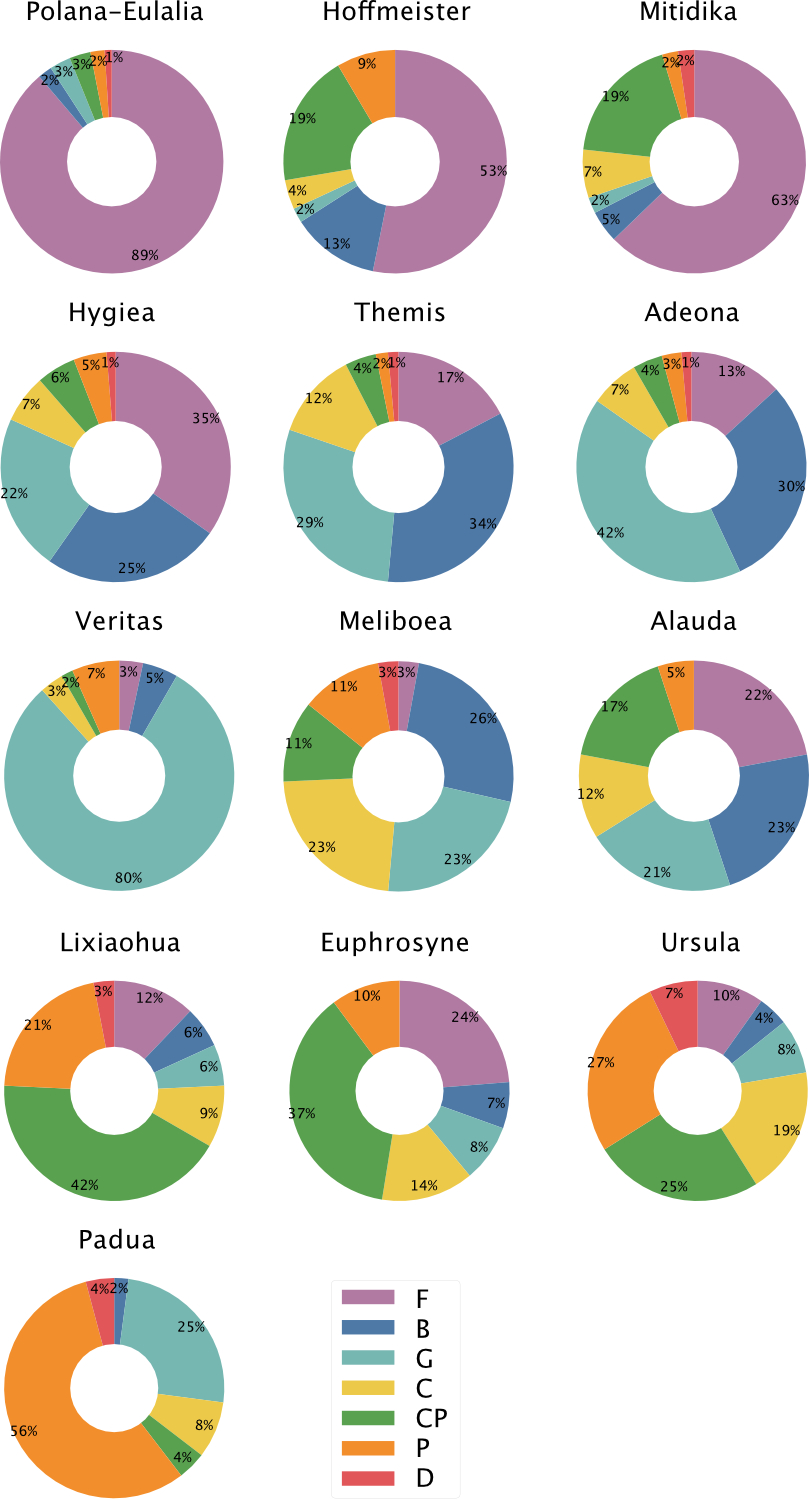- 1Instituto de Astrofisica de Canarias (IAC), Tenerife, Spain (etatsumi@iac.es)
- 2The University of Tokyo, Tokyo, Japan
- 3Planetary Science Institute, AZ, US
- 4Brown University, RI, US
- 5Institute of Space and Astronautical Science (ISAS), JAXA, Kanagawa, Japan
- 6Astronomical Institute of the Romanian Academy, Bucharest, Romania
An asteroid family is a group of asteroids with similar orbital proper elements (e.g., Nesvorný et al. 2005), which could be fragments formed by large impact events. The heating temperature in primordial bodies is important to form various mineralogies observed in asteroids and meteorites. The short-lived radiogenic heat of 26Al is the plausible heat source for the early stages of planetesimal formation. After 5 Myr of CAIs, 26Al decreases by <1%. Heating temperatures caused by 26Al highly depend on the water-to-rock ratio (W/R) and accretion timing in the planetesimal. W/R can be a good indicator of the formation distance from the Sun. However, it should be noted that W/R can be changed by the differentiation process (Wakita et al. 2011, Neumann et al. 2020, Kurokawa et al. 2022). The taxonomic composition of a family can be a witness to the internal structure of a primordial body, before disruption to become a collisional family. The near-ultraviolet wavelengths (NUV; 0.3-0.5 µm) and 0.7-µm absorption band are sensitive to the presence of phyllosilicates (Feierberg et al. 1985, Vilas and Gaffey 1989). The presence or absence of the 0.7-µm band and the NUV absorption suggest a possible differentiation process.
Methods: In this study, in order to cover the NUV to visible wavelength range, using two spectrophotometric surveys, we used SDSS MOC4 (Ivezić et al. 2001) and ECAS (Zellner et al. 1985), for evaluation of the taxonomic configuration of family members. The asteroid family members were classified based on Tholen’s taxonomy (Tholen 1984). Furthermore, the 0.7-µm band (HYD) was evaluated as the slope change between the SDSS r-i filters to i-z filters: HYD=[r-i-(r-i)_sun]-[i-z-(i-z)_sun].
Results: Some of these families had been studied spectroscopically and the fraction of members with 0.7-µm band absorption can be obtained from the literature (Mothé-Diniz et al. 2005, Morate et al. 2016, 2018, 2019, de León et al. 2016, De Prá et al. 2020). Families with negative HYD values have a majority of members with the 0.7-µm band absorption from the spectroscopic studies. Thus, we found the HYD is a good proxy for the 0.7-µm band absorptions, even though the SDSS filters are not optimized for characterizing the 0.7-µm band. Furthermore, a strong correlation (correlation coefficient of -0.69) exists between HYD and the NUV absorption, suggesting that the NUV absorption can be also used for evaluating the presence of Fe-bearing phyllosilicates. The NUV absorption strength decreases from G > C/B > F/CP > P > D, which is in good agreement with the percentage of objects showing 0.7-µm band found by Vilas (1994) and Fornasier et al. (2014). Thus, G types might be dominated by Fe-bearing phyllosilicates in composition, while F types might be dominated by Fe-poor phyllosilicates. The figure shows the taxonomic compositions for primitive asteroid families that have greater than 30 asteroid members. We found several families consist of relatively homogeneous taxonomic types. The collisional families with majority of G type (the highest NUV absorption) are composed of Fe-rich phyllosilicates, and those with majority of F type (the lowest NUV absorption) are composed of Mg-rich phyllosilicates or dehydrated phyllosilicates. There are also intermediate families which consist of variety of taxonomic classes, which may inhere compositional heterogeneity. This heterogeneous families are larger than 200 km, indicating the size of primordial bodies may play a great role to differentiate or produce different lithologies inside the bodies.

Figure. Taxonomic structure of primitive asteroid families.
References: Nesvorný et al. (2005) Icarus 173, 132-152. Wakita et al. (2011) EPS 63, 1193-1206. Neumann et al. (2020) A&A 633, A117. Kurokawa et al. (2022) AGU Acvances 3, e2021AV000568. Feierberg et al. (1985) Icarus 63, 183-191. Vilas and Gaffey (1989) Science 246, 790-792. Ivezić et al. (2001) Astron. J 122, 2749-2784. Zellner et al. (1985) Icarus 61, 355-416. Tholen (1984) PhD thesis from University of Arizona. Mothé-Diniz et al. (2005) Icarus 174, 54-80. Morate et al. (2016) A&A 586, A129. Morate et al. (2018) A&A 610, A25. Morate et al. (2019) 630, A141. De Prá et al. (2020) A&A 643, A102. Vilas (1994) Icarus 111, 456-467.
How to cite: Tatsumi, E., de León, J., Vilas, F., Popescu, M., Hiroi, T., Hasegawa, S., Morate, D., Tinaut-Ruano, F., and Licandro, J.: Internal compositional structure of large primitive asteroids based on the photometric surveys, Europlanet Science Congress 2022, Granada, Spain, 18–23 Sep 2022, EPSC2022-175, https://doi.org/10.5194/epsc2022-175, 2022.

